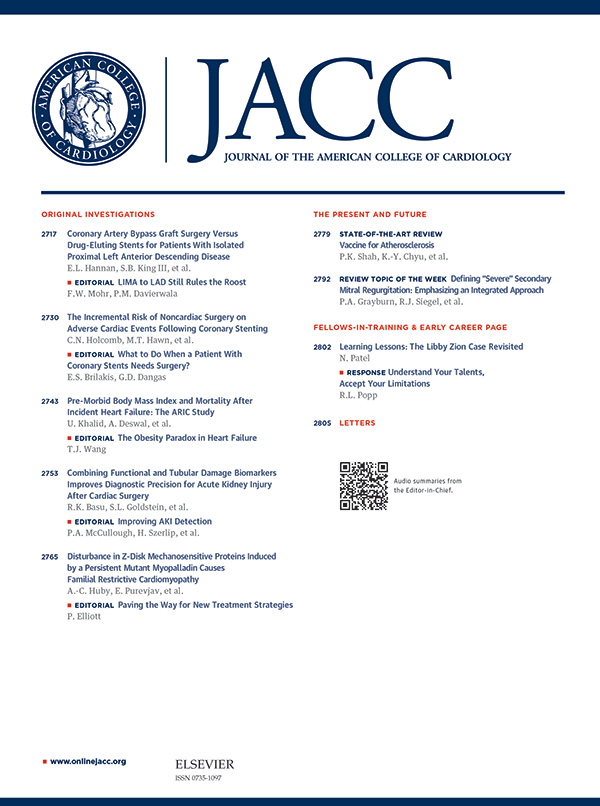10-Year and 30-Year Risks of Cardiovascular Disease in the U.S. Population
IF 21.7
1区 医学
Q1 CARDIAC & CARDIOVASCULAR SYSTEMS
引用次数: 0
Abstract
Background
The American Heart Association PREVENT (Predicting Risk of Cardiovascular Disease Events) equations were recently developed to estimate risk of total cardiovascular disease (CVD), which includes both atherosclerotic CVD (ASCVD) and heart failure (HF). Long-term risks of total CVD in the U.S. population are unknown.
Objectives
This study sought to determine the long-term risks of CVD in the U.S. population.
Methods
Using data on U.S. adults aged 30 to 79 years from the National Health and Nutrition Examination Survey between 2011 and 2020, we determined 10- and 30-year risks of total CVD, ASCVD, and HF based on the PREVENT equations. Age-standardized and survey-weighted risk prevalence was determined with further stratification according to age, sex, race, and ethnicity.
Results
The study population included 14,184 participants aged 30 to 79 years, representing 160.6 million U.S. adults with and without CVD. The prevalence of existing CVD was 9.6%, including 26.8% among adults aged 65 to 79 years. Survey-weighted prevalence of having elevated (≥7.5%) 10-year predicted risk of developing CVD was 20.2%, although only 10.7% were considered at risk for ASCVD and 12.7% at risk for HF. Prevalence of having elevated 10-year risk of developing CVD was 1.0% in adults aged 30 to 44 years, 18.3% in adults aged 45 to 64 years, and 66.3% in adults aged 65 to 79 years. Due to underlying risk factor profiles, men as well as Black and Hispanic adults had higher 10-year risks of total CVD, ASCVD, and HF. Mean 10-year risks of total CVD, ASCVD, and HF modestly increased over time. For 30-year risks, 66.7% of adults aged 30 to 59 years were without CVD but had elevated total CVD risk, including 89.7% of adults aged 45 to 59 years. Men and Black adults had higher 30-year risks of ASCVD and HF.
Conclusions
Three in 10 U.S. adults aged 30 to 79 years have existing CVD or an elevated 10-year predicted risk of CVD, including >90% of adults aged >65 years. Two-thirds of middle-aged adults are without CVD but have an elevated 30-year CVD risk. Men and Black and Hispanic adults are higher risk. These findings emphasize the need for intensive efforts to prevent CVD in the United States.

美国人口10年和30年心血管疾病风险
美国心脏协会的预防(预测心血管疾病事件的风险)方程最近被开发用于估计总心血管疾病(CVD)的风险,其中包括动脉粥样硬化性CVD (ASCVD)和心力衰竭(HF)。在美国人群中,心血管疾病的长期风险是未知的。目的:本研究旨在确定美国人群中心血管疾病的长期风险。方法利用2011年至2020年美国国家健康与营养调查中30至79岁的美国成年人的数据,我们根据prevention方程确定了10年和30年总心血管疾病、ASCVD和HF的风险。根据年龄、性别、种族和民族进一步分层,确定年龄标准化和调查加权的风险患病率。研究人群包括14184名年龄在30至79岁之间的参与者,代表了1.606亿有或没有心血管疾病的美国成年人。现有心血管疾病的患病率为9.6%,其中65至79岁的成年人为26.8%。调查加权患病率升高(≥7.5%)的10年CVD预测风险为20.2%,尽管只有10.7%的人被认为有ASCVD风险,12.7%的人被认为有HF风险。在30 - 44岁的成年人中,患心血管疾病10年风险升高的患病率为1.0%,在45 - 64岁的成年人中为18.3%,在65 - 79岁的成年人中为66.3%。由于潜在的风险因素,男性以及黑人和西班牙裔成年人的10年总心血管疾病、ASCVD和HF的风险更高。随着时间的推移,总CVD、ASCVD和HF的平均10年风险略有增加。对于30年的风险,66.7%的30至59岁的成年人没有心血管疾病,但心血管疾病的总风险升高,其中包括89.7%的45至59岁的成年人。男性和黑人成年人30年患ASCVD和HF的风险较高。结论:30 - 79岁的美国成年人中有3 / 10存在心血管疾病或10年预测心血管疾病风险升高,其中包括90%的65岁成年人。三分之二的中年人没有心血管疾病,但30年心血管疾病风险升高。男性、黑人和西班牙裔成年人的风险更高。这些发现强调了在美国加强预防心血管疾病的必要性。
本文章由计算机程序翻译,如有差异,请以英文原文为准。
求助全文
约1分钟内获得全文
求助全文
来源期刊
CiteScore
42.70
自引率
3.30%
发文量
5097
审稿时长
2-4 weeks
期刊介绍:
The Journal of the American College of Cardiology (JACC) publishes peer-reviewed articles highlighting all aspects of cardiovascular disease, including original clinical studies, experimental investigations with clear clinical relevance, state-of-the-art papers and viewpoints.
Content Profile:
-Original Investigations
-JACC State-of-the-Art Reviews
-JACC Review Topics of the Week
-Guidelines & Clinical Documents
-JACC Guideline Comparisons
-JACC Scientific Expert Panels
-Cardiovascular Medicine & Society
-Editorial Comments (accompanying every Original Investigation)
-Research Letters
-Fellows-in-Training/Early Career Professional Pages
-Editor’s Pages from the Editor-in-Chief or other invited thought leaders

 求助内容:
求助内容: 应助结果提醒方式:
应助结果提醒方式:


